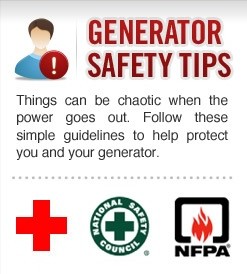Generator Safety Checklist

Portable electric generators are convenient devices that provide electricity when camping, or when the power is down due to service maintenance or inclement weather. However, because generators work with electricity, like any electrical appliance, you should use them with caution and take safety precautions to prevent injury or death. A proper generator safety checklist will minimize your physical risks when operating a generator.
Moisture
Water easily carries electrical currents. Check that the generator is positioned in a dry location, preferably supported above ground level or in an area from which water will drain. Place the generator under a canopy or overhang to keep precipitation off the device. Do not operate the generator during wet weather of any kind if the generator is outside.
Obstruction
When the power is disabled, you will not want to stumble over items to get to the generator. Clear a wide pathway to the generator to prevent falls.
Ventilation
As pointed out by the Powered Generators website, generators produce more carbon monoxide than car engines. Carbon monoxide--an odorless, tasteless and colorless gas--starves the body of oxygen, causing nausea, headaches and even death. To avoid exposing your family and your self to carbon monoxide, place the generator at least 20 feet from the house. Never operate a generator indoors.
Electrical
Check that the cords and wires on the generator are not frayed or exposed. Use only grounded, three-prong electrical plugs and avoid extension cords. Do not plug a portable generator into a wall socket to try to power your home. This can cause electrical damage and place electricians who repair the electrical system at serious risk for electrocution. Hire a licensed electricians to connect a permanent standby generator to your electrical system if necessary. These types of generators are especially designed to handle the electrical demands of the home.
Fuel
Check that the generator is off and cool before attempting to fuel it. Label the generator fuel clearly, and store it in a cool location away from other combustible materials.
Moisture
Water easily carries electrical currents. Check that the generator is positioned in a dry location, preferably supported above ground level or in an area from which water will drain. Place the generator under a canopy or overhang to keep precipitation off the device. Do not operate the generator during wet weather of any kind if the generator is outside.
Obstruction
When the power is disabled, you will not want to stumble over items to get to the generator. Clear a wide pathway to the generator to prevent falls.
Ventilation
As pointed out by the Powered Generators website, generators produce more carbon monoxide than car engines. Carbon monoxide--an odorless, tasteless and colorless gas--starves the body of oxygen, causing nausea, headaches and even death. To avoid exposing your family and your self to carbon monoxide, place the generator at least 20 feet from the house. Never operate a generator indoors.
Electrical
Check that the cords and wires on the generator are not frayed or exposed. Use only grounded, three-prong electrical plugs and avoid extension cords. Do not plug a portable generator into a wall socket to try to power your home. This can cause electrical damage and place electricians who repair the electrical system at serious risk for electrocution. Hire a licensed electricians to connect a permanent standby generator to your electrical system if necessary. These types of generators are especially designed to handle the electrical demands of the home.
Fuel
Check that the generator is off and cool before attempting to fuel it. Label the generator fuel clearly, and store it in a cool location away from other combustible materials.
- p734bfd5593d85d613c3faeb514e05d19f.jpg
- xrdbb410563108bcb973f80bd35edd4c54.jpg
References
http://www.ehow.com/list_6912031_generator-safety-checklist.html
http://bestportablegenerator.biz/images/BPG_INFO_1.jpg
http://www.630wpro.com/images/featured_image/0/paired_modules/6/1360340299_stretch.png